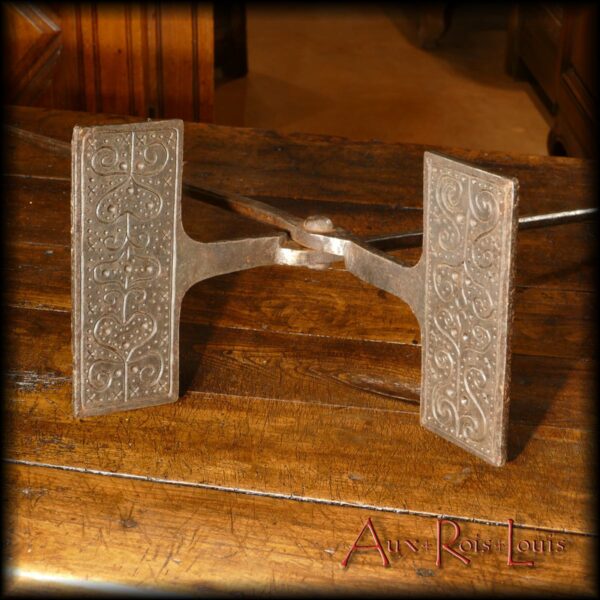Coach Travel Chest in Leather and Wood – 18th Century – Île de France – [ME124]
The vanity one carries with them in the 18th century is made from leather, brass, and wood. These natural materials were assembled by the guild of trunk makers, with no recourse to plastics which of course did not yet exist. Let’s rediscover the charm of yesteryear’s luggage with this delicate coach travel chest in leather, brass, and wood, a surviving witness of the Renaissance’s golden days in France.


![Bronze chandelier – Louis XIV – 17th century – Quercy – [ME117] What characterizes this bronze chandelier from the 17th century is that it has never been converted to electricity. Everything here is original, and only the candles are adapted to its candle holders. Additionally, small vessels are intended to receive walnut oil and wicks to complete the decidedly intimate lighting setup.](https://www.aux-rois-louis.com/wp-content/uploads/2023/11/ME117_P1670115-600x600.webp)
![Royal Cast Iron Fireplace Plate – 17th Century – Périgord – [ME113] Impressively sized, this fireplace plate from the renowned foundries of Périgord showcases traditional royal heraldry, featuring a crown surrounded by fleur-de-lis and pine cones, symbolizing longevity. Cast in 1644, the inclusion of this date in its design adds to its historical appeal and authenticity.](https://www.aux-rois-louis.com/wp-content/uploads/2023/09/ME113_plaque_de_cheminee-600x600.webp)
![Copper Church Steeple Rooster – 19th Century – Languedoc-Roussillon – [MP050] It is believed to have the power to chase away demons, and that's why Pope Leo IV chose it in the 9th century to reign on the steeples of our churches. Very rare, this all-copper church steeple rooster has descended for a while, ready to come protect your home.](https://www.aux-rois-louis.com/wp-content/uploads/2023/09/MP050_P1670068-600x600.webp)
![Bell Bronze Pie Dish – 19th Century – Southwest – [MP043] Here is a pie dish that has the particularity of being cast right after a church bell, in order not to waste any of the molten metal. Therefore, it is made of the same bronze and can be considered the little sister of a bell, just a few minutes apart, though not an exact twin.](https://www.aux-rois-louis.com/wp-content/uploads/2023/06/MP043_570-600x600.webp)
![Kettle, pie dish and decaliter jug in red copper – 18ᵉ century – South West – [MP035] [MP036] [MP037] Three copper containers of exceptional size: an enormous kettle, the matching pie dish and an equally imposing pitcher. All are in red copper and date from the 18th century, a period during which they were manufactured using the same processes in the South West of France.](https://www.aux-rois-louis.com/wp-content/uploads/2022/10/ME035-036-037_426-600x600.webp)

![Small vat in cast iron for the soup Small vat for the soup in cast iron – 17ᵗʰ century – Fonderies du Périgord – [ME077]](https://www.aux-rois-louis.com/wp-content/uploads/2022/05/ME077_P1660136-600x600.jpg)
![Large cast iron vat for laundry Large cast iron vat for laundry – 16ᵗʰ century – Fonderies du Périgord – [ME076]](https://www.aux-rois-louis.com/wp-content/uploads/2022/05/ME076_P1660128-600x600.jpg)
![Sugar boiler for the Colonies – 16ᵗʰ century – Fonderies du Périgord – [ME075] Sugar boiler for the Colonies – 16ᵗʰ century – Fonderies du Périgord – [ME075]](https://www.aux-rois-louis.com/wp-content/uploads/2022/05/ME075_135-600x600.jpg)
![ME079_P1660184det Cast iron fireback – Louis XV – 18ᵗʰ century – South-West – [ME079]](https://www.aux-rois-louis.com/wp-content/uploads/2022/04/ME079_P1660184det-600x600.jpg)
![Cast iron andirons - 18th century - Périgord - [ME062]](https://www.aux-rois-louis.com/wp-content/uploads/2021/09/ME062_013-600x600.jpg)
